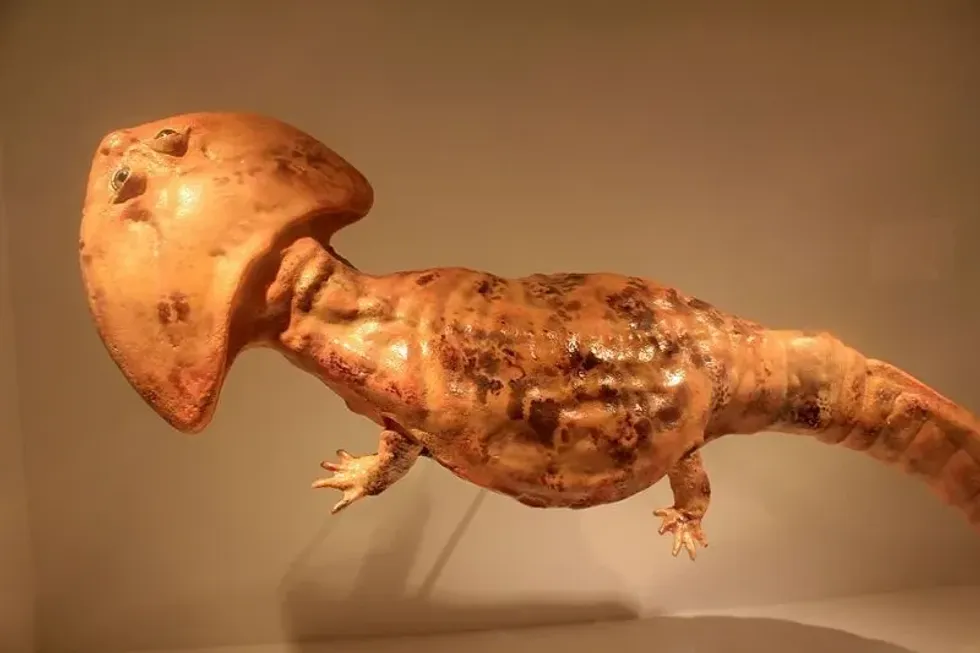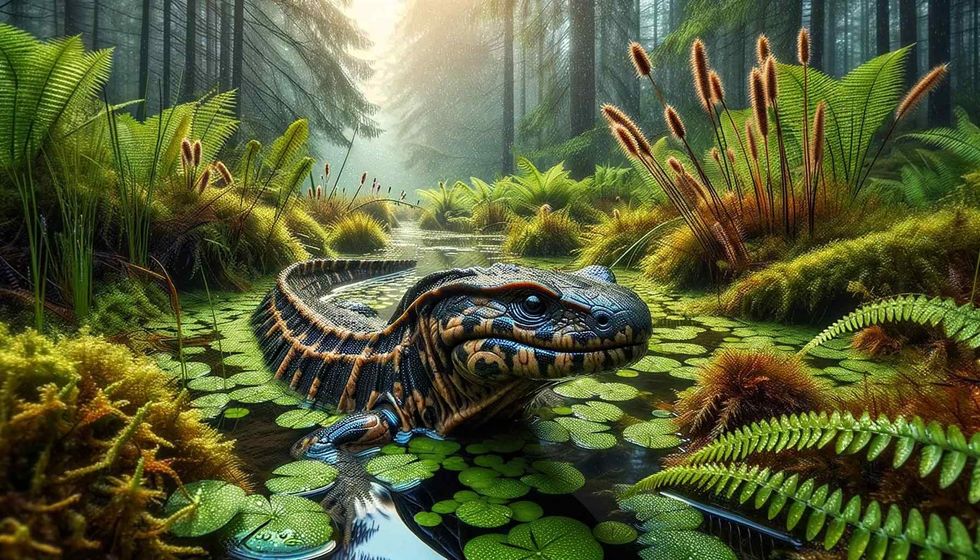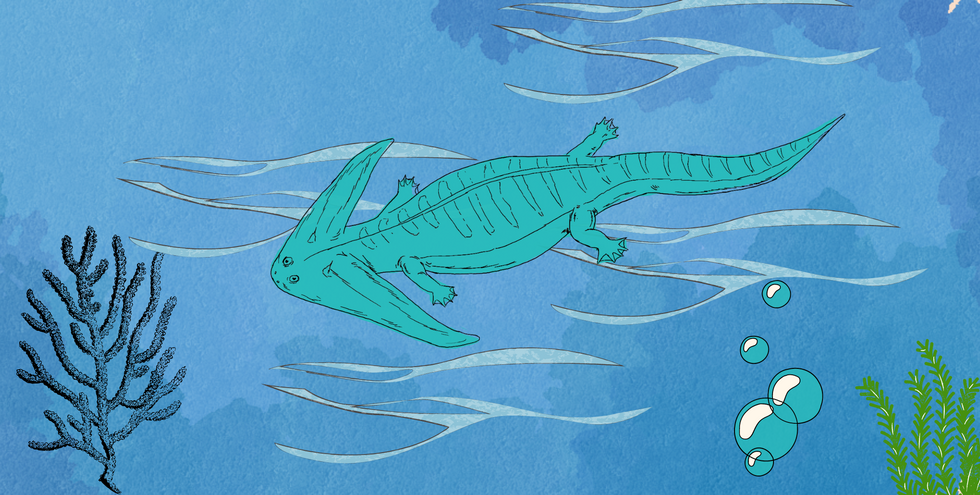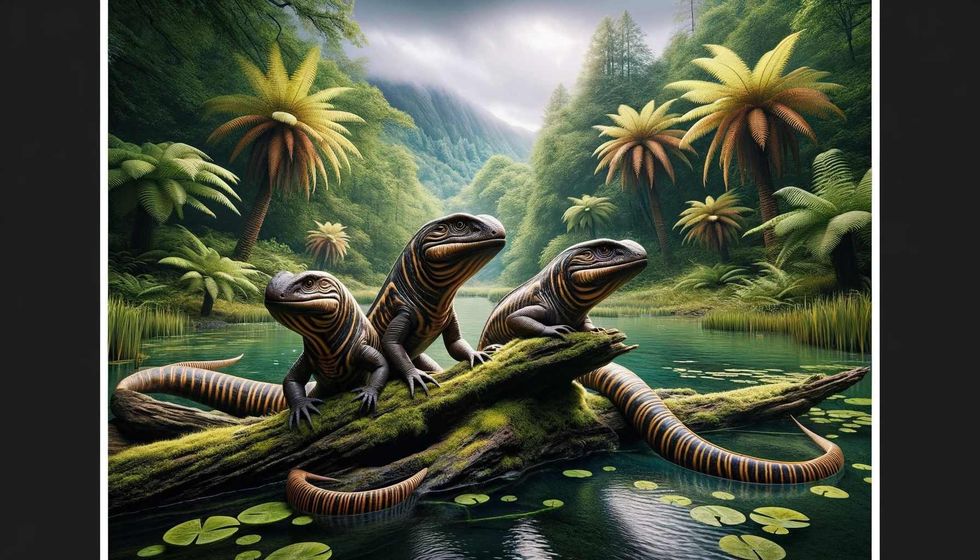Diplocaulus remains one of the most enigmatic creatures of ancient waterways, known for its distinctive boomerang-shaped head and sprawling limbs. This prehistoric amphibian is a subject of fascination for both scientists and the public.
As an inhabitant of the Late Carboniferous and Permian Periods (approximately 270 million years ago), Diplocaulus provides a distinct perspective on a time of significant evolutionary diversification that set the stage for the age of dinosaurs.
Fossilized remains of these long-extinct amphibians ignite curiosity about their lifestyle, hunting methods, reproductive intricacies, and daily survival challenges. Fossil records indicate that this species was related to contemporary amphibians yet distinct due to its unique cranial features. The scientific community recognizes this genus, particularly Diplocaulus magnicornis, as one of several amphibians that prospered in this fertile wilderness.
The Permian Period, marked by turmoil and transition from the preceding Carboniferous Period, saw significant environmental shifts, presenting new challenges to the existing fauna and flora. Diplocaulus, small in size and peculiar in shape, inhabited an environment filled with various predators and prey, pointing to a dynamic and competitive ecosystem.
Sail-backed synapsids, towering arthropods, and a myriad of fish species coexisted with Diplocaulus, contributing to a rich narrative of evolutionary change.
Today, Diplocaulus remains intriguing, its existence immortalized in stone which contributes to the understanding of life's continuous journey through time. As paleontologists uncover more about Diplocaulus's life, they not only piece together an aspect of Earth's distant history but also highlight the resilience and marvel of life on this planet.
Diplocaulus Interesting Facts

How do you pronounce 'diplocaulus'?
The name 'Diplocaulus' is pronounced as 'dip-loh-KAW-lus'.
What type of dinosaur were they?
Diplocaulus was an amphibian, closely related to early tetrapods, not a dinosaur or reptile.
In which geological period did the diplocaulus roam the Earth?

Diplocaulus lived during the Late Carboniferous to the Permian Period (approximately 270 million years ago).
When did they become extinct?
This unique creature became extinct at the end of the Permian Period, marking the first sign of a significant extinction event, although the precise year of their disappearance is not known.
Where did diplocaulus live?
Diplocaulus thrived in the prehistoric waters of North America and Africa during a time when the continent's climate and environment were vastly different.
What was the dinosaur's habitat?
The boomerang-shaped head of the Diplocaulus suggests it was an aquatic species, predominantly found in freshwater ecosystems like swamps, lakes, and rivers rich in oxygen supply.
How long did a diplocaulus live?
The longevity of a Diplocaulus is not currently known. Future research may uncover more information regarding their lifespan.
How did they reproduce?
The reproductive methods of the Diplocaulus are not clearly understood, but as amphibians, they might have laid eggs in water, similar to how contemporary amphibians reproduce. Further research could reveal more details about their reproductive behavior.
Diplocaulus Fun Facts
 diplocaulus
diplocaulus
What did they look like?
Diplocaulus possessed a robust, salamander-like physique yet was notably larger. The full extent of its tail remains a mystery, but in 1917 a near-complete skeleton featured a sequence of tail vertebrae positioned close to the head. This suggested the possibility that Diplocaulus had a slender, extensive tail that could extend to its head when the body was coiled.
How many bones did a Diplocaulus have?
The precise number of bones in a Diplocaulus's skull is currently unknown. Research may eventually shed more light on the details of its distinctive anatomy.
How did they communicate?
The methods of communication used by Diplocaulus remain unknown, and it is an area that requires further research for a clearer understanding.
How big was a Diplocaulus?
The Diplocaulus reached a length of up to 1 m (3 ft).
How fast could they move?
The speed at which a Diplocaulus could move is not precisely documented, and further investigative work is necessary to better understand their locomotion capabilities.
How much did a diplocaulus weigh?
There is currently no available information regarding the weight of a Diplocaulus; future studies are required to establish this aspect of their physiology.
What were the male and female names of the species?
The specific terms used to distinguish male and female Diplocaulus have not been defined and remain unknown, awaiting clarification through additional research.
What would you call a baby diplocaulus?
There isn't a specialized term for a baby Diplocaulus; however, in line with common amphibian terminology, the offspring could be generally referred to as larvae or tadpoles.
How aggressive were they?
There is no definitive information available on the aggression levels of Diplocaulus, and further research is needed to determine their behavioral patterns.
Did you know...
Fossils linked to Diplocaulus, unearthed from Morocco's Late Permian deposits, signify the last known appearance of a lepospondyl in the fossil record.
The discovery of Diplocaulus salamandroides marked the initial identification of the Diplocaulus genus. The species' fossils were unearthed near Danville, Illinois, by local geologists William Gurley and J.C. Winslow, whose findings later came under the scrutiny of the esteemed paleontologist Edward Drinker Cope in 1877.
The known evidence of this species is limited to a handful of vertebrae that were sent to Cope by Gurley and Winslow. These vertebrae drew attention due to their resemblance to those of salamanders, which influenced the species' name, salamandroides. Despite this, Cope hesitated to categorize them definitively within any established group.
Described by Cope in 1882, Diplocaulus magnicornis stands out as the most familiar and thoroughly documented species within its genus. It was the pioneering species to be recognized beyond just its vertebrae, offering Cope and subsequent paleontologists a clearer picture of Diplocaulus as a peculiar, long-horned amphibian.
Contemporary understanding of the genus is heavily derived from this species due to the abundance of its remains, which surpass all others by hundreds. Diplocaulus magnicornis is also noteworthy for its broad temporal range across the red beds of Texas and Oklahoma.
Diplocaulus brevirostris bore a resemblance to its relative Diplocaulus magnicornis but was significantly less common. Represented by a few specimens from the Arroyo Formation within the Texas red beds, Diplocaulus brevirostris is distinguishable by its shorter, more rounded snout in proportion to its skull.
Additionally, this species featured more extended horns, a convex upper surface on the parietals, and a more pronounced and smoother curvature on the skull's rear edge. While the juvenile Diplocaulus magnicornis also exhibited a smoothly curved skull, the known specimens of Diplocaulus brevirostris, identifiable by their developed skull features, elongated horns, and larger size, are recognized as adults.
The species Diplocaulus recurvatus, originating from the Texas red beds' Vale Formation, closely resembled Diplocaulus magnicornis and shared its habitat in more recent geological layers. It was suggested by Olson that Diplocaulus recurvatus could have evolved from an ancestral form of Diplocaulus magnicornis.
In 1951, E.C. Olson posed the idea that the elongated horns of Diplocaulus may have been the framework for skin flaps, aiding in a mode of movement similar to that of skates or stingrays.
Olson acknowledged the speculative nature of this theory, especially in the absence of soft tissue fossil evidence. He also speculated on other functions the creature's expansive head might have served, including using its breadth as a burrowing tool for evasion from predators or to withstand dry conditions.
The notion that the horns played a role in the animal's breathing was revisited by J.R. Beerbower in his 1963 discussion on Diploceraspis, a close relative of Diplocaulus. This theory speculates that the horns could have supported structures akin to operculum flaps, possibly concealing external or internal gills.
An additional theory considers its defensiveness; predators would certainly struggle to ingest an animal with such a wide head.
A group of three juvenile Diplocaulus, along with a juvenile Eryops sharing their burrow, fell victim to a predatory Dimetrodon. This sail-backed synapsid probably discovered the hiding amphibians during a dry spell.
One of the trio suffered a lethal attack with a direct bite to the head, resulting in the loss of part of its skull and brain tissue, a devastating blow it could not withstand.
This genus, along with its nearest kin, was characterized by an unmistakable pair of lengthy horns extending from the back of the skull, which bestowed a boomerang-like appearance upon the head. The prominent outer/front edge of each horn was shaped by the extended, flat squamosal bone.
In contrast, the postparietal bones, referred to as dermosupraoccipitals in earlier literature, shaped the back edge of the skull and horns.
FAQs

Is it a dinosaur?
The Diplocaulus, a genus of lepospondyl amphibians that thrived from the Late Carboniferous to the Late Permian Periods, was not related to dinosaurs. Aligning with the regions of what is known today as North America and Africa, these ancient amphibians are particularly noted for their unique boomerang-shaped skulls.
The shape resulted from two lengthy bones positioned at the skull's rear, sparking theories around its purpose, potentially as a swimming aid that functioned like a hydrofoil or as a form of defense against predators.
What are some facts about the dinosaur?
The Diplocaulus, a now-extinct early amphibian species, dates back to around 270 million years ago in what is known as the Permian Period.
Unearthed for the first time in Texas in 1878, it received its official scientific designation from Edward Drinker Cope a year prior. The term 'Diplocaulus' translates to 'double caul', a nod to its unique boomerang-like head shape, which is comprised of a pair of extended bones at its rear.
The distinctive cranial structure has sparked numerous speculations regarding its purpose, ranging from a defense mechanism against being swallowed by predators to functioning as a hydrofoil for gliding across the water's surface and maneuvering through the water with ease.
When did the Diplocaulus become extinct?
Diplocaulus met its demise by the close of the Permian Period, a time marked by the Permian-Triassic extinction event, one of Earth's most catastrophic extinction episodes. Although a myriad of species perished during this event, the precise moment of Diplocaulus's extinction remains unclear.
Did they live in water?
Diplocaulus was an aquatic dweller that made its home in the freshwaters of ancient swamps and large pools. This amphibian was perfectly equipped for life in the water, with a body crafted for hydrodynamics and limbs resembling paddles, ideal for slicing through water.
Although it could occasionally clamber onto land, the structure of its limbs suggests that they weren't built to support its weight for extended periods or efficient locomotion on solid ground. The diet of Diplocaulus primarily included fish and tiny water-dwelling creatures.
It was a stealthy hunter, often hiding at the bottom of aquatic environments to spring upon unsuspecting prey.
Its eyes, positioned atop its head, gave it a distinct advantage, enabling it to spot potential meals while remaining mostly submerged. The discovery of Diplocaulus fossils in ancient freshwater deposits further corroborates the amphibian's life in watery realms.
The Diplocaulus remains a testament to the diversity of prehistoric life. These intriguing amphibians provide a unique window into the development and challenges of early aquatic creatures.
While they may have faced a hard time on land, they were undoubtedly a master of their aquatic realm, coexisting with fish and evading their predators.
The fossils of this species, including those of young Diplocaulus, continue to fuel various hypotheses and foster a deeper understanding of prehistoric animals. The shape of the Diplocaulus, its lifestyle, and its ultimate demise are areas of avid study, offering invaluable insights into the rich tapestry of life during the Earth's early days.
Related Articles Around the Web






 diplocaulus
diplocaulus





